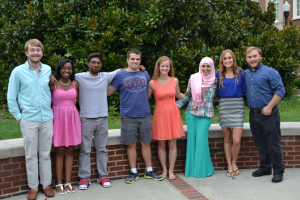Math-Biology REU
2014 Projects
 Summer 2014 Participants
Summer 2014 Participants
- Appalachian State University
- Bennett College
- Miami University
- Michigan State University
- North Carolina State University
- University of North Carolina at Greensboro
- University of North Carolina at Wilmington
Evolution of Cooperation in Mobile population
This project concerned a system of discrete agents operating within a sparsely populated network of patches. The project focused on how these agents moved about the network and formed aggregations. As with many agent-based simulation studies the project model involves stochastically driven events (e.g. movement, competition) in the lifespan of an individual agent. The distinguishing feature of the research conducted here was the mobility of the agents. Each agent move aimed at maximizing agent’s long term fitness. We have investigated how various parameters of the simulation influenced the evolution of cooperation. We found that both greater mobility and larger neighborhood size inhibit the evolution of cooperation because it allows the defectors to find the cooperators faster and exploit them more.
Age-Structured Populations
This project studied the fixation rate of cooperation within an age-structured agent-based network. Many animals have distinct life phases (pre-reproductive, reproductive, and post-reproductive) in which interactions vary with respect to the age of individuals, and that the duration of these phases was subject to selection pressures. The model of this project shared many features with the previous project (e.g. agents that could be either Cooperators or Defectors), but the system transpired on a two-dimensional lattice network of sites and each agent was fixed at a particular location. Individuals were subject to aging and mortality events as well as reproduction and competition for resources with individuals in neighboring cells. The propensity of these events were influenced by an individual’s fitness score, itself a function of the present and historic compositions of its neighborhood. We focused on the effects of memory of past interactions and neighborhood size on the evolution of cooperation. We showed that larger neighborhood sizes are detrimental to cooperation. Further, we showed that larger memories actually hurt the spread of cooperation in small neighborhood sizes. For larger neighborhood sizes, however, longer memories are more favorable to the spread of cooperation than shorter memories.
Social Dynamics
This project regarded the contest between cooperation and defection as a question of behavioral responses amid shifting social compositions. Prior research into the trustworthiness of public signals had shown that one could obtain results that diverged from classic game theory outcomes when there was a mixed-constituent audience or multiple players involved. This project adapted that idea to describe the behavioral changes within a society composed of three inter-dependent classes (taxpayer elites, government and law enforcement, general citizens). Members of each class had a binary choice of actions for dealing with society at large (e.g. being charitable or stingy with resources) that could be equated with either cooperation or defection according to an external assessment of what constituted a just or ideal society. Our goal was to determine the underlying structural dynamics of these models and, secondarily, the conditions necessary to maintain a utopian social archetype where all classes adopted their respective equivalent of cooperate. Charitability was lost under most parametric combinations without a utopian preference among the elite taxpayers, and society either defaulted to a dystopian outcome or cycled through periods of oppression, relaxation, rioting and restoration of order. Although social ideals could stabilize the utopian archetype, that alone did not eliminate the possibility of other attractors within the system, and the system remained initial condition dependent.
Cooperation and Kleptoparasitism
This project placed cooperation and defection in the context of theoretical ecology and per capita fitness functions. A number of papers have recently established a framework for studying the dynamics and spatial distributions of populations capable of adaptive movement. For this project, we considered three variations of a fitness function that describes the local performance in recovering resources from the environment. The three variations are stereotypical expressions of selfishness, cooperation, and exploitation. Respectively, these variations consist of a fitness function that strictly declines with density, another which features an Allee effect at smaller densities, and an exploitative interaction wherein gathered resources are transferred from host individuals to kleptoparasites. We found that host fitness functions mediated the community dynamics under invasion from parasites, with destabilizing cycles affecting cooperative hosts in high resources. Moreover, selfish and cooperative populations were mutually exclusive to one another.





